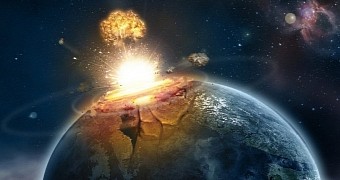Nearly 13,000 years ago, Earth got really cold and stayed so for about a millennium. This moment in our planet's history is known as the Younger Dryas cold period and coincided with the demise of the mammoths and plenty of other beasts.
The thing is that, for the time being at least, researchers cannot say for sure how and why the Younger Dryas cold period came to happen. One theory says that it was the result of a disastrous cosmic impact.
More precisely, the researchers who formulated this theory and who support it believe that the Younger Dryas cold period was brought about by a comet or a meteorite that struck North America ages ago. University of California-Davis scientists disagree.
Thus, in a paper recently published in the Journal of Archaeological Science, specialist Peter Thy and fellow researchers say that there is no evidence whatsoever to confirm the 1980s theory that the Younger Dryas cold period was the result of a comic impact.
Discrediting an decades-old theory
In their report debunking the cosmic impact theory, the University of California-Davis scientists explain that, as part of their investigation, they analyzed several soil samples collected from four different sites in northern Syria.
The focus was on pinning down rock soil droplets believed to have formed by heating. These so-called siliceous scoria droplets associated with melting were then compared with others previously argued to have been created by the cosmic impact that led to the Younger Dryas cold period.
It was discovered that, rather than being similar, as one would expect in the aftermath of a meteorite or comet impact that would have affected all the continents, the rock soil droplets were quite different from one another. More precisely, their composition was related to local soils.
Besides, based on their makeup, researchers determined that the droplets had formed not due to exposure to intense temperatures but because of short-lived heating events. Add to this the fact that the droplets greatly varied in terms of their age, and the cosmic impact theory is pretty much out.
“For the Syria side, the impact theory is out. There’s no way that can be done,” said study leader Peter Thy. “If there was one cosmic impact, they should be connected by one date and not a period of 3,000 years,” the researcher went on to comment on his and his colleagues' findings.
OK, so where did the rock soil droplets come from?
The University of California-Davis researchers say that, rather than having been birthed by a disastrous comet or meteorite strike, the rock soil droplets previously argued to be evidence of a cosmic impact that occurred almost 13,000 years ago are in fact the result of Stone Age house fires.
More precisely, it is argued that the siliceous scoria droplets formed when buildings made of local soil and straw, and that were part and parcel of ancient agricultural settlements along the Euphrates River, burned to the ground.

 14 DAY TRIAL //
14 DAY TRIAL //